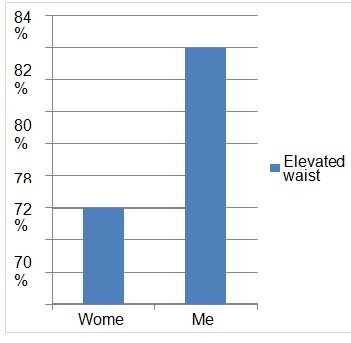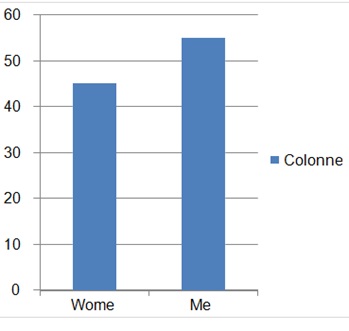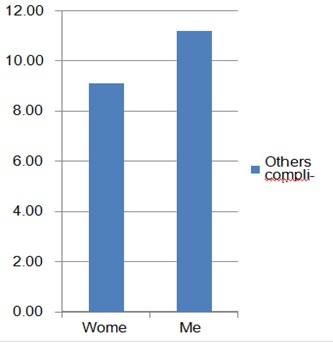
Morphotype and Hypertension in Type 2 Diabetics
*Corresponding Author(s):
Ghouini APhysiology Laboratory Faculty Of Medicine, Blida 1 University, Ouled Yaïch, Algeria
Tel:+ 213 773839184,
Email:ghouinia@yahoo.fr
Abstract
Type 2 diabetes is a metabolic and nutritional disease accompanied in its evolution by complications of several orders, in particular when overweight is associated with this disease; cardiovascular complications are the most severe and high blood pressure stands out in the foreground. Our work aims to demonstrate the association between morphotype and hypertension.
Keywords
Morphotype; Type 2 diabetes; Hypertension
INTRODUCTION
Objective of the study
Type 2 Diabetes (T2D) exposes to cardiovascular comorbidities and other equally serious complications [1-3]. Our study looked at the morphotype of T2D subjects and cardiovascular risk in order to envisage a nutritional support strategy and an adapted physical activity program to correct deleterious morphotypes.
Patients / Methods
It is a prospective study of the group of descriptive studies, carried out during the year 2018. Adult patients of both sexes come from 3 municipalities in the Chlef region (200 km west of Algiers). 114 subjects were selected on the basis of their adherence to the different methods of investigation (anthropometry, clinic, biology).
- • inclusion criteria: subjects whose body mass index (BMI = weight in kg / m2) is above 18.5 kg / m2, subjects of 2 sexes aged 18 - 65 years
- • criteria for non-inclusion: lean, malnourished subjects, subjects suffering from endocrine disorders, children and subjects aged over 65
The anthropometric profile was assessed by measuring the waist circumference (TT) better correlated with the type of obesity and more predictive of comorbidities than the body mass index alone; the blood pressure profile is determined by the regular taking of blood pressure and the progression of diabetes by glycemic control (blood glucose and HbA1c).
Statistic study
The Statistical Package of Social Science (SPSS 17.0) software was used for the statistical study. To judge the statistical significance of the parameters, we used the Student test (t). The 95% confidence interval represents the interval that contains the true value of the parameter with a 5% risk of error. The parameters are presented as averages.
For the comparison of the means, the result is given in the form of a p (statistical significance). If p ≥ 0.05: the comparison is not significant, if p < 0.05: the result is significant and if p = 0.001: the result is highly significant.
RESULTS
- • 46 % of women have a TT ≥ 80 or = 88 cm and 60 % of men have a TT ≥ 94 cm (i.e. level 1 with a risk of cardio-metabolic complications).
- • 26 % of women have a TT ≥ 88 cm and 22% of men have a TT ≥ 102 cm in men (i.e. level 2 exposing to the high risk of cardio-metabolic complications).
- • In total 72% of women and 82% of men have an abnormally high waist circumference.
- • 4% of the subjects are hypertensive whereas 20.3% among the consultants have others complications added to arterial hypertension (9, 1% in women and 11,2 % in men).
- • The glycemic balance objectified by fasting glycemia and glycated hemoglobin is fluctuating or even poor. (Figures 1,2 and 3)
 Figure 1: The elevated waist size is observed in the majority of patients, more in men (82%) than in women (72%).
Figure 1: The elevated waist size is observed in the majority of patients, more in men (82%) than in women (72%).
 Figure 2: -54.4% of the subjects are hypertensive of which 45 % are women net 55 % are men.
Figure 2: -54.4% of the subjects are hypertensive of which 45 % are women net 55 % are men.
 Figure 3: Among hypertensive patients 9% of women and 11% of men have other comorbidities.
Figure 3: Among hypertensive patients 9% of women and 11% of men have other comorbidities.
DISCUSSION
The pathogenesis of hypertension in diabetics is complex and involves several biological and environmental factors, as well as a genetic predisposition; therefore, diabetic hypertension poses a greater danger of problems and complications. Diabetics who do not get Blood Pressure (BP) control (i.e., a target value of less than 130/80 mm Hg) have a higher mortality and morbidity rate. Large randomized clinical trials and meta-analyzes of randomized clinical trials have shown that a pharmacological reduction in BP alone is the most effective way to reduce death and disability rates in diabetics, including the risk of cardiovascular problems [4,5].
The most effective measures to prevent adverse events are the detection and management of hypertension in diabetic patients. All health professionals must work harder to improve the hypertension control rates in diabetic patients. The effects of improved BP control on mortality and stroke rates are substantial and translate into cost savings to the health system [6-8].
To help doctors, nurses, pharmacists and other healthcare professionals manage hypertension more consistently in diabetic patients, it is imperative to carry out a good control of the glycemic and lipid profile (the dyslipidemia of type 2 diabetes is characterized by quantitative and kinetic, and qualitative, abnormalities of lipoproteins, all atherogenic, and participating in the residual cardiovascular risk of T2D patients) and as, it was shown in our study to take care to reduce the abdominal fat; the rise in waist size is indeed a deleterious factor predicting the installation of major comorbidities [9,10].
CONCLUSION
High blood pressure remains the main complication in T2D subjects, in particular, in overweight subjects; it is correlated with obesity and in particular with the android morphotype. To this end, the weight loss project must be focused, mainly on reducing waist circumference. Appropriate dietetics and an adapted activity program are the fundamental means of correcting the anomalies of the morphotypes characterizing type 2 diabetes.
REFERENCES
- Sowers JR, Epstein M, Frohlich ED (2001) Diabetes, hypertension, and cardiovascular disease: an update. Hypertension 37: 1053-1059.
- Stamler J, Vaccaro O, Neaton JD, Wentworth D (1993) Diabetes, other risk factors, and 12-yr cardiovascular mortality for men screened in the Multiple Risk Factor Intervention Diabetes. Care 16: 434-434.
- Gaede P, Lund-Andersen H, Parving HH, Pedersen O (2008) Effect of a multifactorial intervention on mortality in type 2 diabetes. N Engl J Med 358: 580-591.
- Norm RC, Gilbert RE, Leiter LA, Larochelle P, Tolbe Sheldon, et al. (2011) Hypertension in type 2 diabetics. Pharmacological treatment update. Can Fam Physician 57: 347-353.
- Bild D, Teutsch SM (1987) The control of hypertension in persons with diabetes: a public health approach. Public Health Rep 102: 522-529.
- AFSSAPS- HAS (2006) Type 2 diabetes treatment: French recommendations for good practice AFSSAPS - HAS.2006. Diabetes Metab 32: 643-648.
- GIN H (2003) Nutrition and Diabetes: Practical Encycl Méd Chir (Elsevier SAS), Akos 3.
- Grimaldi A (2009) Treatise on diabetology, 2nd Medicine Sciences, Flammarion.
- Ekoe JM, Goldenberg R, Katz P (2018) Diabetes Canada 2018 Clinical Practice Guidelines for the Prevention and Management of Diabetes in Canada: Screening for Diabetes in Adults. Can J Diabetes 42: 16-19.
- Vergès B (2019) Physiopathologie de la dyslipidémie du diabète de type 2 : nouvelles perspectives. Médecine des maladies métaboliques 13: 140-146.
Citation: Ghouini A, Boukoufa A, Khelfat K (2020) Morphotype and Hypertension in Type 2 Diabetics. J Phys Med Rehabil Disabil 6: 058.
Copyright: © 2020 Ghouini A, et al. This is an open-access article distributed under the terms of the Creative Commons Attribution License, which permits unrestricted use, distribution, and reproduction in any medium, provided the original author and source are credited.

